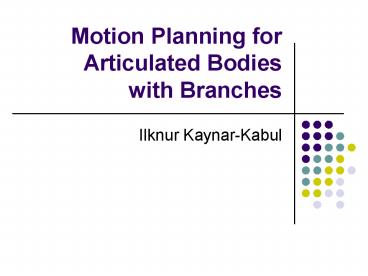Motion Planning for Articulated Bodies with Branches PowerPoint PPT Presentation
1 / 14
Title: Motion Planning for Articulated Bodies with Branches
1
Motion Planning for Articulated Bodieswith
Branches
- Ilknur Kaynar-Kabul
2
Multi-branch articulated body
- Motion planning for multi-branch articulated body
Initial configuration
Final configuration
3
State of the art
- The method consists of building and searching a
graph connecting the local minima of a potential
function defined over the configurations pace. - The graph is explored by means of a randomization
technique that escapes the local minima by
executing Brownian motions. - This planner is considerably faster than previous
path planners and it solves problems with many
more degrees of freedom.
Automatic Motion Planning for Complex Articulated
Bodies, Jérôme Barraquand, 1991
4
State of the art
- In this approach, each of the sub-problem is
solved by using numerical potential fields
defined over bitmap-based representations of the
2-dimensional sub-spaces. - An efficient backtracking mechanism based on a
novel notion of virtual forbidden regions in
these 2-dimensional subspaces is presented.
- Practical Global Motion Planning for Many
Degrees of Freedom A Novel Approach Within
Sequential Framework, - Kamal K. Gupta, Xinyu Zhu, ICRA 1994
5
Goal of the project
- Motion planning for many degrees of freedom (DOF)
arms - Constrained based motion planning will be applied
to each branch - Each branch will have its own goal configuration
- A guiding path for each branch will be found (?)
- The length of the branches will be a constraint
in the guiding path computation - While the branches are following their path,
constraints will be applied for achieving the
dynamic properties of the cable, handling the
collisions and positional constraints (?) - Constraints of each branch will effect the other
branches - The simulation may get unstable because of the
competition of branches and constraints
6
What has been done?
- Literature survey
- Discussion of ideas with Russ
- 2 approaches
- Hierarchical motion planning
- Priority based motion planning
- Some coding
7
Hierarchical motion planning
- Apply constraint based motion planning to each
branch - Find paths for the leaf nodes and apply
attraction forces to make them follow the path - After they reach their goal configurations,
adjust the positions of the parent nodes in the
hierarchy from bottom-up
B
A
D
A
E
F
B
C
G
C
E
F
G
D
8
Priority based motion planning
- It is an iterative approach
- Find path for branch i and make it to follow the
path and come its goal configuration - Apply step 1 to branch i1, then branch i2, n
- Issues in this approach
- The assignment of priorities to the branches
- The performance of prioritized planning versus
coordinated planning
9
Priority based motion planning
- It will be very slow for long chains
- There is no guarantee that you will be able to
find a path for branch i1 after you adjust the
path for branch i - A solution to this problem can be to recompute
the path for branch i if we cannot find a path
for branch i1. But this makes it very slow. - Narrow passages and complex obstacles may be a
problem
10
Implementation
- Adaptive dynamics (AD) code for articulated body
simulation from Stephane and Russ - I generated the multi-branch articulated body
using AD - PRM Constraint based sampling Potential
forces for goal Handling Positional Constraints
are ready
11
What remain to be done
- It is very difficult to come up with a complete
solution to this problem - Current plan is to propose an approach for
solving this problem under some assumptions - There wont be any intersection between the paths
of the branches - There may be more than one solution to the
problem - The lengths of the branches will be sufficient to
reach the goal configurations
12
Expected contributions by the end of the semester
- If we can find an approach that works in most of
the cases under certain assumptions, this will
be the first constraint based approach for
multi-branch articulated bodies
13
Other long term goals
- The algorithm can be applied to legged robots and
reconfigurable robots - There might be applications such as
- Multi-branch cable route planning
- Legged robot moving on the terrain
14
Questions Ideas

